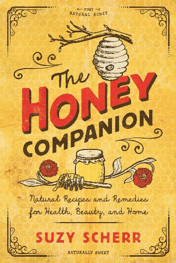The River Journal caught up with local chef and author, Suzy Scherr, to learn more about her new book The HONEY COMPANION: Natural Remedies for Health, Beauty, and Home.
 What inspired you to write this book?
What inspired you to write this book?
I’m a personal chef and a cooking instructor and I’m always looking for new and creative ways to use everyday ingredients. Honey is something that everyone has at home. They may use it in their tea or drizzle it on a piece of toast – but that just barely scratches the surface of the amazing and delicious things we can do with honey. People typically think “sweet” is the beginning and end of what honey can do to food, but the truth is that it is an amazing way to balance flavor. It’s a great counterpoint to strongly flavored foods, acidic foods, rich foods – like cheese, for example. I love honey as part of a beautiful cheese platter!
What was the most interesting thing you learned about honey while doing your research?
Honey literally never goes bad. I read about some archeologists who opened King Tut’s tomb in the 1920s and found a 3,000-year old container of honey that was perfectly preserved. I’m not sure if anyone tasted it, but I’m putting my money on the intern going first.
How many different kinds of honey are there?
Tons! There are as many different kinds of honey as there are types of flowers, since a bee can collect pollen and nectar from any flowering plant that produces it. But in the U.S. it’s estimated that there are about 300 types of commercially available honey.
Besides eating it, what else can you do with honey?
Honey has all kinds of really cool uses for beauty, health and home. For one thing, it’s antiviral, antibacterial, and full of antioxidants, which makes it useful as a defense against illness and infection, but also as a secret skincare weapon, since it’s super moisturizing and gentle on the skin. In fact, there’s such a thing as medical grade honey, which is used as a therapeutic remedy in hospital burn units. There’s also a growing body of research that suggests eating local, raw honey can help tame seasonal allergies. The uses are mind-bogglingly endless!
Are bees really in trouble?
There’s been a huge decline in the global bee population – not just honeybees, but all kinds. Researchers are still trying to get to the bottom of it, but one major contributing factor has been humans taking over more space that belonged at one time to flowering trees and plants. The good news is that by supporting beekeepers, eating more honey and planting more pollinator-friendly gardens and landscapes, we can all help the bees.
I’ve been afraid of bees my whole life – now we’re supposed to be buddies?
Honeybees are actually very gentle and won’t attack unless they’re threatened. If you give them their space, they’ll likely leave you alone.
What’s the difference between mass produced honey and what I find at my local farmers market?
The farther you are from the source of your honey, the less sure you can be that you’re getting real, raw honey. Most of the stuff you’ll find on supermarket shelves has been processed – super heated and filtered. Some of it isn’t even actually honey at all! There’s actually a lot of counterfeit honey out there that looks, smells and tastes like honey but is essentially honey-flavored syrup that offers zero health benefits. Steer clear. Whenever possible, go straight to the source, and get to know your local beekeepers!
Suzy Scherr is a personal chef and culinary instructor. Her recipes and writing have been featured in Parents and Rachael Ray Every Day and she has appeared on The Today Show. The author of The Apple Cider Vinegar Companion and The Baking Soda Companion, she lives with her family in Pleasantville. Learn more or contact Suzy at www.suzyscherr.com/.







